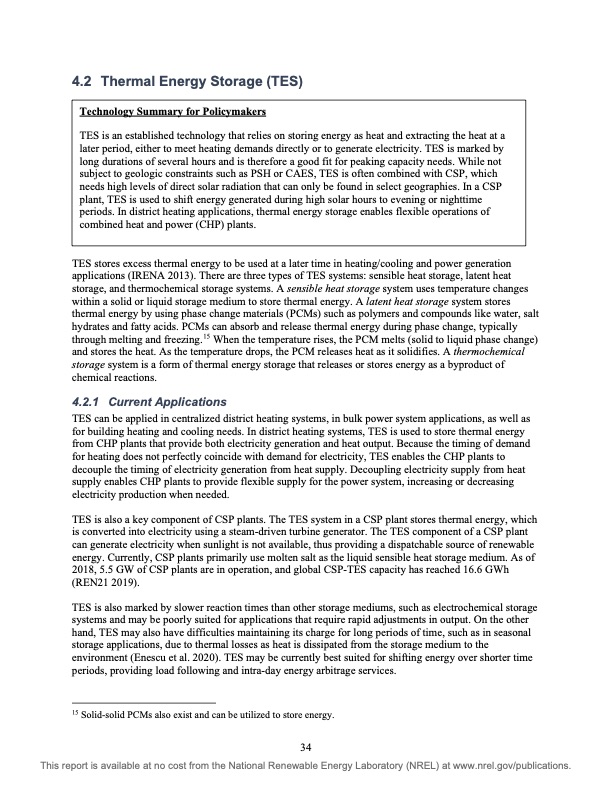
PDF Publication Title:
Text from PDF Page: 041
4.2 ThermalEnergyStorage(TES) Technology Summary for Policymakers TES is an established technology that relies on storing energy as heat and extracting the heat at a later period, either to meet heating demands directly or to generate electricity. TES is marked by long durations of several hours and is therefore a good fit for peaking capacity needs. While not subject to geologic constraints such as PSH or CAES, TES is often combined with CSP, which needs high levels of direct solar radiation that can only be found in select geographies. In a CSP plant, TES is used to shift energy generated during high solar hours to evening or nighttime periods. In district heating applications, thermal energy storage enables flexible operations of combined heat and power (CHP) plants. TES stores excess thermal energy to be used at a later time in heating/cooling and power generation applications (IRENA 2013). There are three types of TES systems: sensible heat storage, latent heat storage, and thermochemical storage systems. A sensible heat storage system uses temperature changes within a solid or liquid storage medium to store thermal energy. A latent heat storage system stores thermal energy by using phase change materials (PCMs) such as polymers and compounds like water, salt hydrates and fatty acids. PCMs can absorb and release thermal energy during phase change, typically through melting and freezing.15 When the temperature rises, the PCM melts (solid to liquid phase change) and stores the heat. As the temperature drops, the PCM releases heat as it solidifies. A thermochemical storage system is a form of thermal energy storage that releases or stores energy as a byproduct of chemical reactions. 4.2.1 Current Applications TES can be applied in centralized district heating systems, in bulk power system applications, as well as for building heating and cooling needs. In district heating systems, TES is used to store thermal energy from CHP plants that provide both electricity generation and heat output. Because the timing of demand for heating does not perfectly coincide with demand for electricity, TES enables the CHP plants to decouple the timing of electricity generation from heat supply. Decoupling electricity supply from heat supply enables CHP plants to provide flexible supply for the power system, increasing or decreasing electricity production when needed. TES is also a key component of CSP plants. The TES system in a CSP plant stores thermal energy, which is converted into electricity using a steam-driven turbine generator. The TES component of a CSP plant can generate electricity when sunlight is not available, thus providing a dispatchable source of renewable energy. Currently, CSP plants primarily use molten salt as the liquid sensible heat storage medium. As of 2018, 5.5 GW of CSP plants are in operation, and global CSP-TES capacity has reached 16.6 GWh (REN21 2019). TES is also marked by slower reaction times than other storage mediums, such as electrochemical storage systems and may be poorly suited for applications that require rapid adjustments in output. On the other hand, TES may also have difficulties maintaining its charge for long periods of time, such as in seasonal storage applications, due to thermal losses as heat is dissipated from the storage medium to the environment (Enescu et al. 2020). TES may be currently best suited for shifting energy over shorter time periods, providing load following and intra-day energy arbitrage services. 15 Solid-solid PCMs also exist and can be utilized to store energy. 34 This report is available at no cost from the National Renewable Energy Laboratory (NREL) at www.nrel.gov/publications.PDF Image | USAID GRID-SCALE ENERGY STORAGE TECHNOLOGIES PRIMER

PDF Search Title:
USAID GRID-SCALE ENERGY STORAGE TECHNOLOGIES PRIMEROriginal File Name Searched:
76097.pdfDIY PDF Search: Google It | Yahoo | Bing
Turbine and System Plans CAD CAM: Special for this month, any plans are $10,000 for complete Cad/Cam blueprints. License is for one build. Try before you buy a production license. More Info
Waste Heat Power Technology: Organic Rankine Cycle uses waste heat to make electricity, shaft horsepower and cooling. More Info
All Turbine and System Products: Infinity Turbine ORD systems, turbine generator sets, build plans and more to use your waste heat from 30C to 100C. More Info
CO2 Phase Change Demonstrator: CO2 goes supercritical at 30 C. This is a experimental platform which you can use to demonstrate phase change with low heat. Includes integration area for small CO2 turbine, static generator, and more. This can also be used for a GTL Gas to Liquids experimental platform. More Info
Introducing the Infinity Turbine Products Infinity Turbine develops and builds systems for making power from waste heat. It also is working on innovative strategies for storing, making, and deploying energy. More Info
Need Strategy? Use our Consulting and analyst services Infinity Turbine LLC is pleased to announce its consulting and analyst services. We have worked in the renewable energy industry as a researcher, developing sales and markets, along with may inventions and innovations. More Info
Made in USA with Global Energy Millennial Web Engine These pages were made with the Global Energy Web PDF Engine using Filemaker (Claris) software.
Sand Battery Sand and Paraffin for TES Thermo Energy Storage More Info
| CONTACT TEL: 608-238-6001 Email: greg@infinityturbine.com | RSS | AMP |